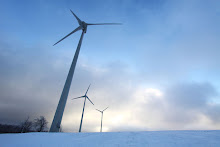The world's scientific community (in stark contrast to some of the world's political community) now generally agrees that man's activities in burning carbon-based fuels (coal, petroleum and natural gas) is resulting in raised concentrations of greenhouse gasses which increase the earth's average temperature and destabilize weather patterns. If the trend continues, results could be severe and include melting of ice packs, flooding of low lying areas, interruption of food production, and increased incidents of severe weather.
The largest single greenhouse gas is carbon dioxide (CO2). About 40% of the CO2 emitted in the United States (which is responsible for about one-quarter of the world's CO2) is the result of electric power production. More of this if from coal generation than any other source (coal generation emits about twice as much CO2 per unit of output than natural gas generation). Control technologies for CO2 emissions from traditional power plants are not currently available.
In December 1997 a number of countries agreed to the Kyoto Protocol-a historic agreement that is designed to reduce greenhouse gas emissions by establishing national emissions limits and provide for global trading in greenhouse gas emissions credits. The major industrial powers of the EU, the United States and Japan agreed to cut emissions by 8%, 7%, and 6% respectively below 1990 levels over a five-year period beginning 2008 and to create a global emissions credit trading program. As with all treaties, the Kyoto Protocol requires ratification by each signatory country. In the United States, the Senate is required to ratify treaties. After the Presidential election in 2000, the Bush Administration announced that it would not support the Kyoto Protocol and has never requested that the Senate ratify it. The Kyoto Protocol as ratified by the majority of European countries, Japan and Canada, and went into effect in February 2005. The participating countries are now moving forward with implementation of greenhouse gas caps and international trading of greenhouse emissions credits.
Meanwhile in the U.S., a number of states are have moved forward with regulation of greenhouse gases, and federal regulation will be implemented in the near future.
UPDATE:
EPA has extended the deadline for reporting 2010 GHG data to September 30, 2011. This extension will allow EPA to further test the system that reporters will use to submit data, and give industry the opportunity to test the tool, provide feedback and have sufficient time to become familiar with it prior to reporting.
In response to the FY2008 Consolidated Appropriations Act (H.R. 2764; Public Law 110–161), EPA issued the Mandatory Reporting of Greenhouse Gases Rule (74 FR 5620) which requires reporting of greenhouse gas (GHG) data and other relevant information from large sources and suppliers in the United States. The purpose of the rule is to collect accurate and timely GHG data to inform future policy decisions. In general, the Rule is referred to as 40 CFR Part 98 (Part 98) 1. Implementation of Part 98 is referred to as the Greenhouse Gas Reporting Program (GHGRP).
Suppliers of certain products that would result in GHG emissions if released, combusted or oxidized; direct emitting source categories; and facilities that inject CO2 underground for geologic sequestration or any purpose other than geologic sequestration, are covered in Part 98. Facilities that emit 25,000 metric tons or more per year of GHGs are required to submit annual reports to EPA. Part 98 was published in the Federal Register (www.regulations.gov) on October 30, 2009 under Docket ID No. EPA-HQ-OAR-2008-0508-2278.
skip to main |
skip to sidebar
Energy Forecast & Updates
